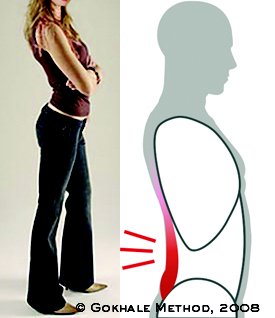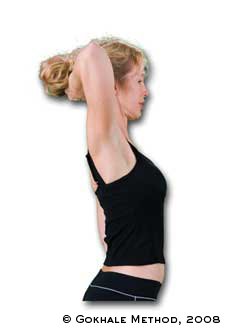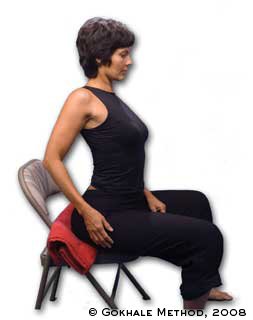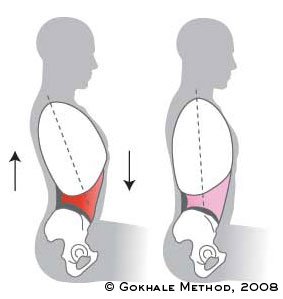Fixing a Sway Back
Though a sway back is commonly perceived as good posture, most people recognize it to be a problem. What is the best way to fix a sway? And for those of you who don’t quite know, what is a sway?

Arching the low back is common and problematic.
A swayback is an inappropriate curve usually in the upper lumbar spine. It is frequently the result of trying to “sit up straight,” or “stand up straight” in a sustained way. Sometimes it is the result of modern activities, most notably women’s gymnastics, women’s ice-skating, women’s ballet and misguided forms of yoga.

The directive to "stand up straight" often results in a swayed low back.
Swaying compresses the discs and decreases circulation around the spine.
I know this problem intimately. Having done a great deal of misguided gymnastics and yoga growing up, I had a very pronounced swayback in my twenties. People complimented me on my posture (sways certainly make you appear upright), but I blame the sway for weakening my lumbar spine and the resulting problems I had with my back in my mid-twenties (this is no longer such a young age to have back problems, I regretfully note).

Esther demonstrating her previous habit of arching the back to be "upright"
The conventional fix for a sway is to tuck the pelvis. But this causes as many problems as it solves. It is true that tucking the pelvis usually flattens a swayback, and often feels good because it stretches out the low back muscles, but tucking the pelvis also compromises the wedge-shaped L5-S1 disc. In my own case, I suspect that the tucking exercises I was taught after my initial episodes of back pain in my teens and early twenties contributed to my more serious L5-S1 disc herniation problem in my later twenties.
The better way to address a sway is to tuck the ribs. By this I mean rotate the ribcage forward so as to make the lower border of the ribcage flush with the abdomen. As the lower ribcage descends and retreats into the contour of the torso, the lower back lengthens, flattens and has a healthier architecture.

Tucking the rib cage-- a healthy way to flatten the low back.
This move is usually quite difficult for those who need it most. If you have been swaying your back for years/decades, tucking the ribs makes you feel hunched (it shows whatever hunch you have, which you now want to address directly with shoulder rolls, neck lengthening, etc.) and ape-like. A quick glance in a mirror should reassure you that you don't look the way you feel. This is always a major aha! moment in our Gokhale Method Foundations course. So there you have it - tuck your ribs, not your pelvis!

Comments
I would like to be clear here
I would like to be clear here about this move you recommend, but how on earth one tucks their ribs or rotate the ribcage forward? Unfortunately, your descriptions and instructions are too vague for me.
Every time I try to Tuck in
Every time I try to Tuck in my rib cage with my fist, my pevils tucks in. I just don't seem to understand.
This is common - it means you
This is common - it means you are much more clued into using your rectus abdominis muscles than your internal obliques. Go very slowly to give this new pattern a chance. It can also help to assume a "ready" stance (like in sports), which makes it easier to maintain your pelvic position no matter what else is going on up higher in your body.
Hi, If I've understood it
Hi,
If I've understood it correctly, 'sway' means that the hips are swayed in front of the ankles which also creates compensatory changes like slouching and forward head posture to the upper body.
The back also has an arch because of the weak core and this is why sway back is often mixed up with anterior pelvic tilt.
This works for me when I tuck my pelvis or bring it above my ankles. The tuck gives me the final relief. This is not possible if hamstrings and anterior tibialis are tight. Core, glutes and hip flexors also need a workout and I have to release the thoracolumbar region.
Im not a pro so not sure if this the most recommended solution.
This is a simple, but not at
This is a simple, but not at all easy, technique. Unfortunately, it's hardest for the people who need it the most! Show up for one of our free workshops all over the world, and one of our teachers will help you find this move as part of stretchsitting. Stretchsitting also helps your brain "memorize" this new way of being with your ribcage.
Here are some additional directions to help you in the mean time:
Kinesthetic things are best learnt from a teacher / coach, but you can make a good beginning with the book and our online resources. Good luck!
Add New Comment
Login to add commment
Login